B2B eCommerce: Definition, Models, Trends & Examples (2025)
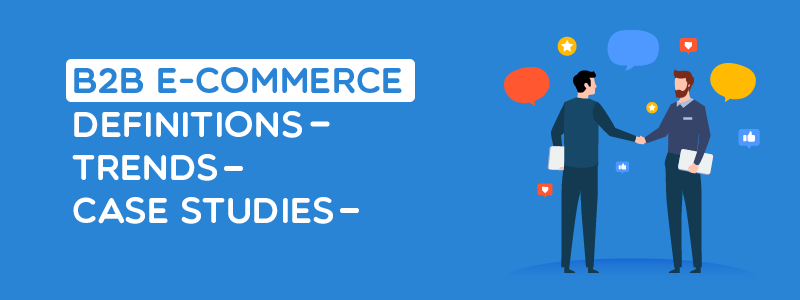
A plethora of B2B eCommerce companies that are now growing around the clock. Statistics have shown that B2B eCommerce sales are expected to reach more than $3,128.5 billion worldwide in 2027.
So, for people who are clueless about every aspect of B2B (business-to-business), a type of electronic commerce (eCommerce) platform, this article is going to take you through to a deeper understanding of this huge potential market. For any B2B business owner, staying up-to-date to the global B2B eCommerce movements is totally needed.
What is B2B eCommerce?
Definition
To comprehend the dynamics of online business interactions, you must define B2B eCommerce accurately. B2B eCommerce is short for business-to-business eCommerce, which is defined as the sales of goods or services between businesses via online channels. Instead of receiving orders in the traditional ways (by telephone or mail), transactions are carried out digitally, which helps reduce a great amount of overhead costs.

The importance of B2B eCommerce
Neglecting digital platforms in the 21st century risks falling behind. People prefer online shopping, making B2B eCommerce a smart investment for million-dollar revenues. The B2B eCommerce sector surged to $10.6 trillion in 2018. 94% of North American B2B executives deem it pivotal, debunking the idea that it won’t impact your business.
So, if you think B2B eCommerce cannot affect your business, then you are totally mistaken. Also, these days, B2B customers want a “B2C-like” experience including quicker checkout process, fast delivery, easy and automatic repeat orders and improvement in tracking.
To handle all of these requirements, a powerful B2B eCommerce website is very crucial because it enhances customer experience at a higher level, positively improving conversion rate in the long term to gain profitability.
Differences between B2C eCommerce and B2B eCommerce in 2025
| Aspect | B2B eCommerce | B2C eCommerce |
|---|---|---|
| Audience size | SmallerFocused | LargerDiverse |
| Prices | Usually higher and negotiable | Generally lower but fixed |
| Decision complexity | Involves multiple departments | Typically individual decision |
| Buying behavior | Focuses on long-term goals | Often impulse or emotional |
| Impact of errors | High-value purchasesCritical | Low-valueLess significant |
| Purchase frequency | Repeat business is common | Depend on each individual and their interest |
| Buyer scope | Represents entire organizations | Individual consumers |
| ROI pressure | Focus on profit and resale | Driven by emotions |
| Payment methods | Various, including net terms | Digital wallets, cards, or cash |
| Online channels | Specific channels for targeting | Using various channels for research |
| Buying behavior | Using psychology to connect | Understanding human behavior |
While both involve selling online, B2B eCommerce meaning involves selling to other businesses, and B2C is about selling to individual customers.
However, in 2025, eCommerce business to business is becoming more complex compared to B2C. To succeed in this competitive eCommerce market, B2B companies need to invest more in research, focus on meeting specific customer needs, and reduce marketing-driven approaches. At the same time, they must provide a customer experience similar to B2C.
How B2B eCommerce Works in 2025
B2B eCommerce involves suppliers selling to businesses. They can do this by setting up their own websites or using online marketplaces like Shopee or Alibaba, where sellers and buyers meet to trade. In brief, B2B eCommerce is simply defined as eCommerce between businesses or companies, rather than between a business and a consumer.
Supplier’s Process (B2B Sales Pipeline): Suppliers go through the following steps:
- Prospecting: Find potential customers, either online or in person.
- Qualification: Check if the lead matches your ideal customer.
- Proposal: Present your offer, including benefits and pricing.
- Negotiations: Discuss terms like price and quantity, mostly online.
- Closing: Finalize the deal with contracts and payments.
- Retention: Keep customers happy for long-term relationships.
Buyer’s Process (B2B Buying Process): Buyers go through the following stages:
- Problem Recognition: Identify their need for products or services.
- Information Search: Research online for suitable options.
- Evaluation: Compare suppliers based on various factors.
- Purchase: Place an order, negotiate, and pay online.
- Post-Purchase Activity: Provide feedback, reviews, or surveys to help sellers improve and encourage repeat purchases.
In summary, B2B eCommerce involves a structured online process for both sellers and buyers to connect, trade, and build lasting relationships.
Types of B2B eCommerce
There are several B2B ecommerce model types, including manufacturers, wholesalers, distributors, B2B2C, and SaaS businesses.
B2B2C (Business To Business To Customer)
B2B2C is an abbreviation for Business To Business To Customer, reflecting a business model that involves collaboration between two business entities (B2B) to deliver products to end consumers (B2C). Through this combination, B2B2C maximizes the strengths of two common business models, B2B and B2C.
Examples of the B2B2C business model include Booking.com which connects partner hotels (B2B) with end consumers (B2C), Alibaba which links manufacturers (B2B) with retail customers (B2C), and UberEats which facilitates food delivery from restaurants (B2B) to consumers (B2C).
These B2B2C models illustrate the synergy between B2B and B2C elements, creating a win-win situation where businesses can expand their reach while offering seamless experiences to end consumers.
Benefits of the B2B2C approach:
- Reach more customers by using an established business platform
- Try new things and work with different partners to grow business
- Save money on things like branding, marketing, and administration when partnering with well-known partners
- Maintain fair pricing through transparent information across eCommerce channels
Wholesale
Wholesale eCommerce refers to the online buying and selling of goods in large quantities to retailers or businesses for the purpose of resale or trade.
Wholesalers are individuals or entities that purchase goods in bulk from distributors and then resell them to other retail units. They do not directly supply goods to consumers; rather, retail units are the final entities that deliver products to customers.
Examples of B2B wholesale eCommerce businesses include Uline, which offers wholesale packaging, shipping, and office supplies, and Wholesale Central, an online marketplace connecting bulk distributors with suppliers and product options.
Benefits of the Wholesale approach:
- Easy to sell large quantities of products to various locations
- Reduce costs for marketing and customer care since retail systems handle these responsibilities primarily
- No need for inventory and order processing
- Easy to expand sale operation globally
Manufacturer
Manufacturers is a B2B eCommerce type in which companies that produce products (such as machinery, raw materials, or finished goods) use eCommerce platforms to connect and transact with other businesses (e.g., those purchasing their products or services). Transactions may include ordering, payment processing, and order management.
3 examples of Manufacturer business in the B2B eCommerce sector:
- 3M: Multinational conglomerate with diverse products across industries. Uses B2B eCommerce to manage transactions and business partners.
- GE Appliances: Sells household products and appliances, uses B2B eCommerce to interact with distribution and retail partners.
- Bosch: Global technology and services company. Leverages B2B eCommerce to connect and facilitate transactions with business partners worldwide.
Benefits of the Manufacturer approach:
- Direct control production ensures product quality and consistency
- Achieve economies of scale for leading to cost-efficiency
- Allow B2B customers to request custom orders, such as tailored packaging and branding
Distributor
In the B2B eCommerce system, distributors collaborate closely with manufacturers to gain insights into their products, boost their visibility in the market, and increase sales.
They use B2B eCommerce platforms to streamline the entire process, from inventory management to product promotion and sales management. Their aim is to deliver goods to customers efficiently while enabling manufacturers to focus on their core competencies without worrying about selling, order processing, packaging, and shipping.
Ingram Micro, DHL Supply Chain, and Graybar are prominent distributors that source and deliver technology, supply chain services, and electrical products to global markets, streamlining manufacturers’ access and optimizing goods transportation and storage.
Benefits of the Distributor approach:
- Access to a large pool of B2B customers that can be shared by manufacturers or suppliers.
- Easy offering of a variety of products from different manufacturers without the need to manufacture the goods themselves.
- Profitability from large deals as B2B typically involves larger orders compared to B2C.
- Effective management of the transportation of goods from manufacturers to customers.
SaaS
The SaaS (Software as a Service) model, which stands for Software as a Service, in B2B eCommerce system, is a way of delivering software and online services to businesses and organizations operating in the field of electronic commerce. This is a rapidly growing business model that aims to offer cloud-based software solutions to enterprises for managing and enhancing their eCommerce operations.
Shopify Plus, BigCommerce, Magento Commerce (owned by Adobe), and Zoho Commerce are leading SaaS companies in B2B eCommerce. They provide customized solutions for online store management, order processing, ERP integration, and personalized shopping experiences.
B2B eCommerce Marketing Tactics
Unlike B2C eCommerce marketing, B2B eCommerce marketing does not need to be flashy to attract consumers.
Business customers want in-depth information about product specifications, features, and usage. So, provide them with detailed information.
Invest in SEO
Investing in SEO is a straightforward and powerful marketing strategy for eCommerce business to business. It helps your website rank higher on search engines, particularly Google. This is essential because search engines are the primary tool for potential customers to discover your products when they’re ready to buy.
Account-Based Marketing (ABM)
Account-Based Marketing (ABM), a marketing method with roots dating back to the 1990s before the internet boom we have today, remains effective even in emerging platforms like eCommerce.
With ABM, each business concentrates on the specific needs of its customer base to develop a suitable approach. The following steps are a general process that can be applied to everyone:
- Research and mine data to identify target accounts.
- Determine decision-makers and influencers within the identified accounts.
- Personalize messaging when addressing issues and challenges related to the identified accounts.
- Select the communication channels to use when reaching out to the identified accounts.
- Review and assess the effectiveness of your messaging and sales efforts, adjusting when necessary.
Send Informative Emails
In most of today’s marketing tools, email marketing is a cost-effective and efficient means of reaching and introducing services and products to the right target customers.
However, to implement effective email marketing, you need to understand the following:
- Start by researching and analyzing the market. Study both direct and indirect competitors. These initial steps are crucial to ensuring the effectiveness of your email marketing campaign.
- Collect email subscribers through every possible channel, from social media platforms like Facebook and LinkedIn to your website.
- Effective subscriber retention is often more important than acquiring new subscribers. Focus on keeping your current subscribers engaged.
- The more specific your target customer profiles are, the more effective your email marketing will be. Therefore, gather in-depth information about your industry, the challenges your customers face, the solutions your business can provide, and create separate email lists for each group with similar characteristics, needs, or preferences.
- Automating your email marketing efforts using various tools and systems will optimize costs.
Run Online Ad Campaigns
To effectively advertise your B2B eCommerce company, consider these platforms:
- Industry publications and websites
- Social media
- Google Ads
- eCommerce SaaS platforms like Shopee, Lazada, Alibaba, etc.
- Retargeting – Using anonymous cookie-based technology to deliver relevant ads across the web.
In my experience, to run successful ad campaigns, prioritize:
- LinkedIn, remarketing, and industry-focused ads – These yield higher click-through rates and conversions by targeting industry-specific audiences directly.
- Search engine marketing (SEM) – While effective, it can be costly for professional service keywords.
- Maximize PPC investment by promoting specific products, services, brand personality, blogs, and social media content.
- Facebook advertising may be less effective for professional services, as B2B buyers favor other social networks more.
Enhance Video Content
In 2025, video content will remain a crucial asset for B2B marketers. Wyzowl’s yearly report on video marketing shows that 92% of video marketers had a positive return on investment (ROI), which is a new record.
High-quality video content has the power to capture audience attention, effectively convey brand messages, and demonstrate the value of products or services. However, in 2025, video marketing goes beyond just creating and posting videos on your owned business channels:
- Videos must be authentic, relevant, and tailored to your target audience. The messages conveyed through video should be well-suited, timely, and delivered to the right people.
- Viewers need to grasp the message within the first 20-30 seconds of the video. If the beginning doesn’t engage them, they’ll quickly close the video and move on to other content.
- Videos should evoke emotions and tell a clear story, highlighting the strengths of your business.
- Monitoring key performance indicators (KPIs) for video effectiveness is essential, unless you want to waste your budget on unprofitable campaigns.
Influencers Marketing
Using influencers is effective not only for B2C but also for B2B eCommerce businesses. We all understand that when businesses are looking for suppliers, they conduct extensive research before making decisions. Therefore, using a reputable figure in the industry to promote our services or products can increase the reach to potential customers and enhance credibility.
However, the ideal influencer for B2B eCommerce businesses should not necessarily have high interaction or a large following. These factors are far less important than relevance to the industry, industry credibility, and expertise. Therefore, ideal B2B influencers often are:
- Executives
- Entrepreneurs
- Keynote speakers
- Thought leaders
- Authors/bloggers
- Podcasters
B2B eCommerce Myths
Myth #1: B2B buyers prefer in-person meetings.
Reality: Two-thirds of B2B customers prefer digital or remote interactions. eCommerce has become the most effective channel, with online chat and video conferencing gaining popularity.
Myth #2: B2B eCommerce can eliminate sales teams
Reality: Two-thirds of B2B customers prefer digital or remote interactions. eCommerce has become the most effective channel, with online chat and video conferencing gaining popularity.
Myth #3: Running an online store is cheap and easy
Reality: Two-thirds of B2B customers prefer digital or remote interactions. eCommerce has become the most effective channel, with online chat and video conferencing gaining popularity.
Myth #4: Revenue is the only metric
Reality: While revenue is vital, it shouldn’t be the sole metric. Consider conversion rates, website traffic, asset values, and social media engagement to measure business performance and growth potential.
As mentioned earlier regarding the suitability of the SAAS model for your e-commerce business, creating new campaigns and accurately tracking data provides a comprehensive overview of your business’s revenue and expenses. So, how can you achieve this? Like Shopify, you can directly add the Google Tag Manager (GTM) code to your website. However, with Magento, you can utilize Magento 2 Google Tag Manager extensions offered by Magento product providers. Both methods, regardless of the platform, enable you to precisely track data in Google Analytics 4 (GA4) once you’ve created new campaigns.
Myth #5: Mobile optimization isn’t just a nice-to-have for B2B eCommerce businesses
Reality: Mobile optimization is crucial, as over 60% of B2B buyers start purchases on smartphones. Your website should offer seamless navigation and valuable functionality on mobile devices.
Learn more: [Top 10 Best eCommerce Platforms in 2025]
Top B2B eCommerce trends in 2025
More Customer Touchpoints Needed
B2B consumers conduct extensive research before making a purchase, and the number of channels they use to gather information about suppliers is increasing. Consequently, B2B companies need to seek and invest in more customer touchpoints throughout their buying decision journey.

Post-Order Stages Need to Be Faster
Customer expectations regarding order delivery times are on the rise. Additionally, more B2B commerce companies are excelling in faster order fulfillment as a competitive advantage. Therefore, any business that lags in delivering orders may lose customer satisfaction and lead to decisions not to repeat purchases.
Personalized Experience is Crucial
Many customers now anticipate seamless, personalized experiences that align with their current stage in the buying journey.
A survey by McKinsey & Company with nearly 3,500 decision-makers in 12 markets revealed their desire for even more personalized experiences.
B2B buyers also expect brands to convey more targeted messages. A study by Salesforce found that 52% of B2B customers are likely to switch brands if a company doesn’t tailor communications to their needs. Furthermore, 80% of B2B buyers say they are more inclined to engage with a brand that offers personalized experiences.
More payment methods to satisfy business customers
Undoubtedly, payment is always an important step of any business transaction. So, when it comes to B2B digital payment, there are certain trends that sellers may want to pay attention to so that they can add suitable payment methods to satisfy business customers.

The story now is not just about the typical “credit card only” when you offer payment options to B2B buyers. There are many other methods that the customers would like to see on your checkout page including cash, check or purchase order. According to a BigCommerce’s survey on over 500 international B2B retailers:
- 94% prefer to pay by credit card
- 53% opt for paying by terms
- 51% are willing to pay by check
- 50% agree with purchase orders
- 26% choose to pay through mobile wallets such as Apple Pay or Amazon Pay, and the number is still increasing.
All in all, it is difficult for many business owners to offer all types of payment, but depending on the business cases, they should wisely choose the most suitable methods to the B2B audience for better checkout experience.
Chatbots as a member of your customer service team
Using chatbots will still be a leading trend in B2B eCommerce. The first and foremost reason is that chatbots are one of the best solutions for great customer service, which help improve the customer shopping experience. Chatbots can reduce a great amount of waiting time since they are programmed to find information more quickly than a salesperson, not to mention that they can work 24/7.
Read this article to learn more about using AI chatbots to revolutionize the customer experience.
Augmented Reality and Virtual Reality
AR is an emerging trend in B2B eCommerce, offering visual and interactive product experiences. It reduces sample production costs, aids self-research, and enhances efficiency for buyers.
Leading brands like Cisco employ AR for virtual machine demonstrations. VR is another futuristic tool, instructing product configuration without physical items. Both AR and VR are transformative for marketing and the future of B2B eCommerce.
CPQ technology with voice-assisted intelligence
Voice technology such as Alexa or Siri is now taking over the world. It is obvious that this type of voice assistant is a must-known trend which B2B business owners need to watch out for. By using these assistants, more time will be saved since they can provide customers with instant results which a salesperson hardly does.
However, voice-controlled devices alone cannot make a business more powerful in the complex world of B2B. Meeting intricate B2B requirements demands smarter tools like CPQ (configure, price and quote) since it can utilize a company’s data on product catalogs, customer information, previous transactions and integrates other enterprise platforms.
Omnichannel B2B eCommerce
Customers come first. If you want to boost your revenue and increase conversion rate, then there should be a huge improvement in the customer experience. eCommerce buyers, especially B2B customers, are now changing, and they are more independent with higher expectations towards B2B merchant. Thus, an omnichannel strategy is critically important to meet their complicated demands.

Some of the strategies B2B firms can implement to develop an omnichannel customer experience are:
- Investing in SEO to gain more organic traffic to the company’s website, and increase the site ranking on the first result page. Check out the Plugin SEO magento if you are looking for a piece of advice.
- Spending budget on digital advertising such as search ads or product listing ads.
- Using social media to promote the company’s brand and increase engagement with followers for further conversion rate optimization.
- Combining with setting up optimized FAQ page and extended shopping cart, smart filtering options, product comparison functionality to enhance the customer experience.
5 Examples of successful B2B eCommerce brands
Polycom
Perhaps every conference room around the world is equipped with a Polycom three-point phone which is an iconic product of the company for decades. This global corporation is the leader in providing collaboration and content solutions such as video conferencing and voice calling, which power authentic human connection and collaboration.
The company’s website is a perfect example for a very simple and friendly B2B e-Commerce platform, but on a global scale. When entering the site, customers can choose regions or countries where they are located so that they can easily use the website in their languages for a better experience.
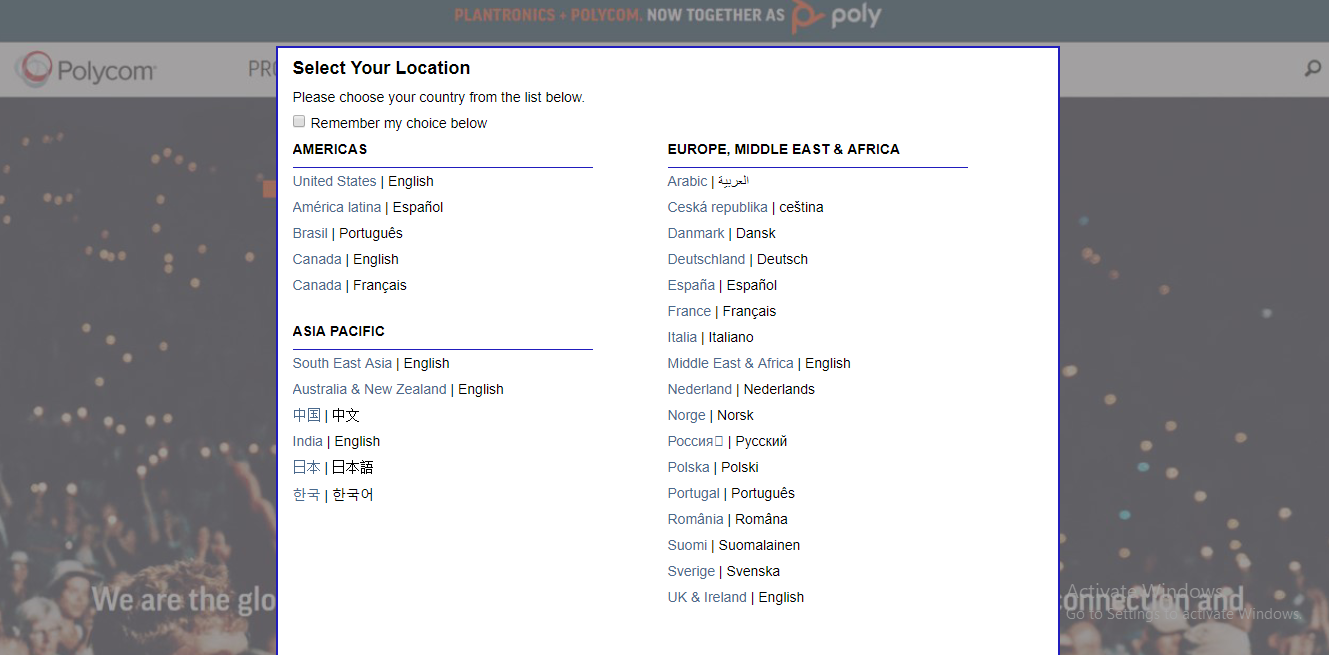
What makes this platform more friendly to B2B buyers is the clear and direct navigation - like products & services, solutions, partners and support. Also, there is a chat box that pops up at the left corner of the page so that customers can ask whatever they want. The right side of the page shows the “request a quote” and “request a demo” features, and when users click on these parts, there will be a square box where they have to fill in their information for further transactions.
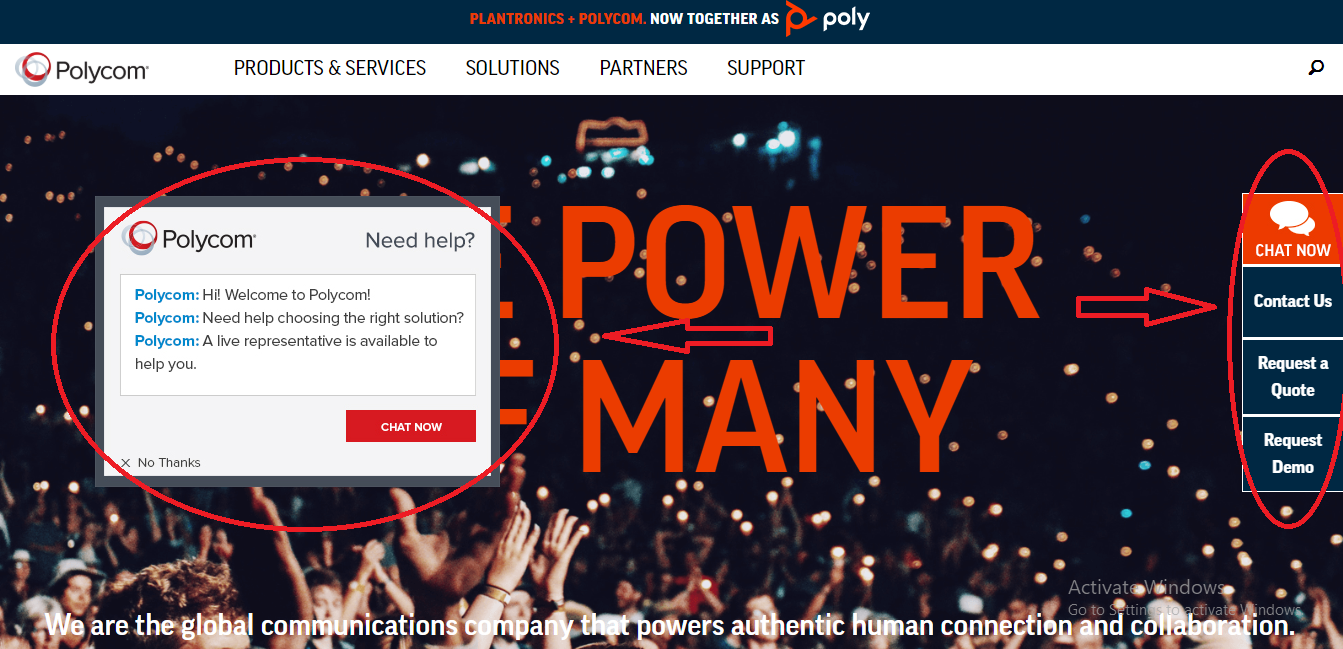
Basically, Polycom mainly simplifies the user experience on the website, which is based on the customers’ demands for immediate collaboration solutions, and many companies should learn from this since understanding what customers actually need is crucial for a successful business.
Spectrum Audio
When you first enter the Spectrum Audio website (a pro audio, stage lighting, DJ equipment provider), the professional look ,in general, is all you can see. The site has clear navigation and easy to follow with an optimized search box. Right into the home page, customers can know about promotional prices depending on how much they are going to buy. Also, scrolling down the page, users will be educated with the latest products, featured products and most popular ones, which is a smart strategy to increase buyers’ shopping cart size.
For B2B buyers, there is one great feature that Spectrum Audio has set up is the “add to quote” button powered by Quoteninja for custom orders with higher quantities. If you stop your mouse on any product picture, you will see the “quick view” and “compare” function. Clicking on the “quick view”, there will be an immediate product description and information box with its pictures without moving to another page, and you can see the “add to quote” button, as well. For the “compare” one, it doesn’t seem really work. However, the general experience on the site is great.
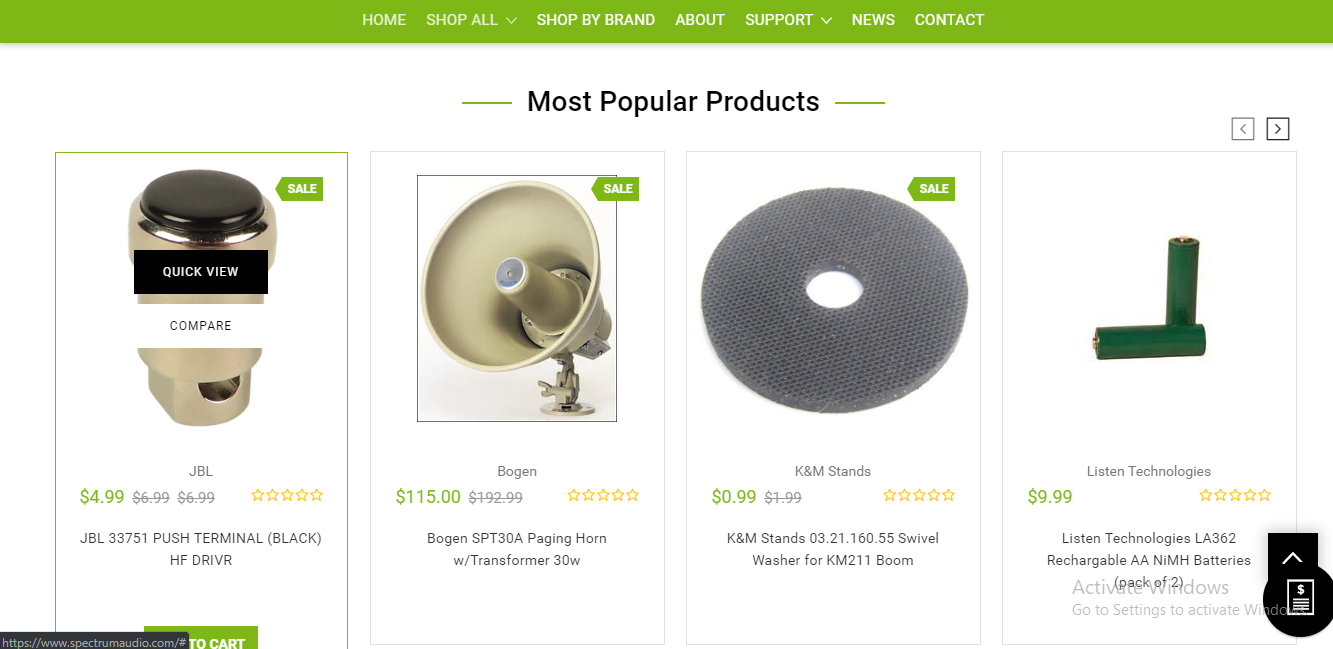
Another cool thing about this website is the “shop by brand” on the navigation bar. The brands are sorted from A to Z, which is pretty convenient for customers who have a specific brand in mind. After clicking on a certain brand, users can easily find the products they want by price or category.
Grainger
W.W. Grainger Inc. is an American Fortune 500 industrial supplies and equipment company with more than 1.6 million products to keep its business customers running. This leading provider of industrial facilities management equipment invests heavily in their online platform, and has acquired billions of dollars in e-Commerce sales.
As mentioned before, search is very essential for B2B buyers. So, what Grainger website can do to facilitate customer’s searching products process is by optimizing search box and using extended filtering options. In particular, Grainger uses Autofill to autocomplete as user types in the search box. If you happen to misspell the keyword, don’t worry because there will be a list of suggestions for you to find the right product. Also, the filter menu on the left side helps you find products with detail specification that fits your business case. For example, if a customer wants to buy LED light bulbs, there will be many options to choose from the case filters such as lighting technology, light appearance, watts, etc. so that you can choose the most suitable one.
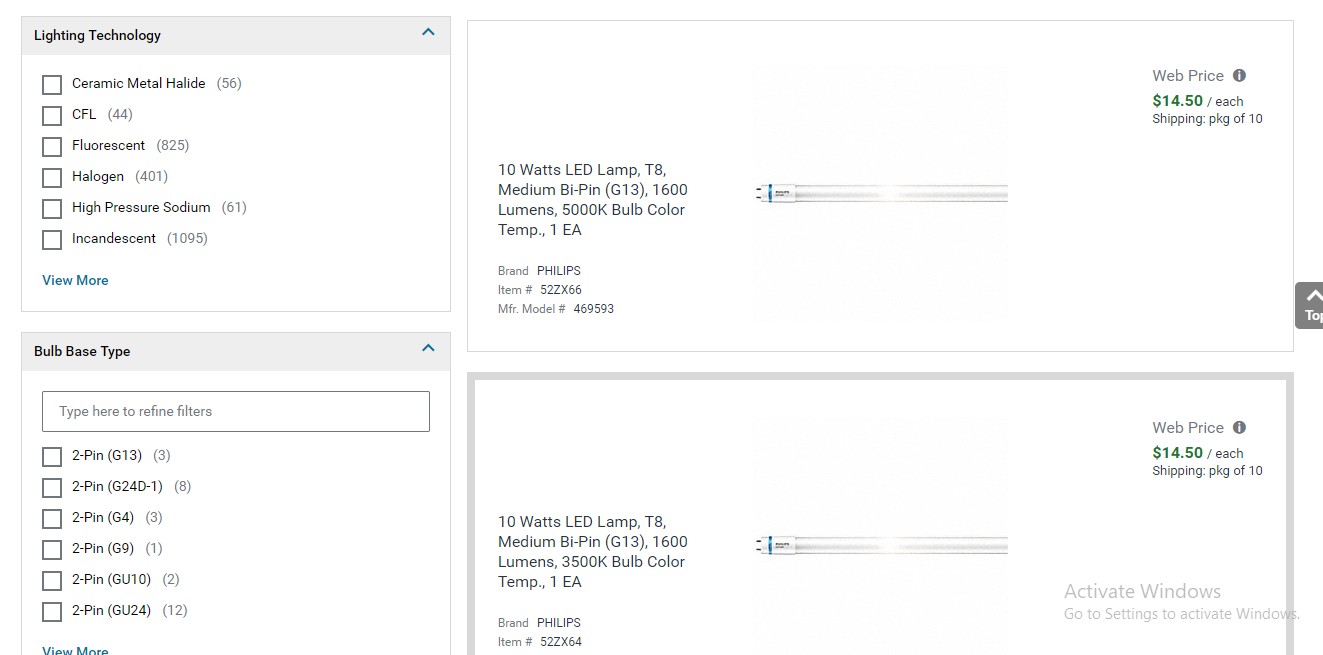
Grainger also lets buyers compare products by themselves when they select particular products under a comparison tick-box in order to get the best option. This huge e-Commerce platform is aggressively developed in the mobile version, as well since there is an increase in the number of buyers using iPad to buy products.
Chocomize
This is one of the top companies in providing corporate gifts, especially customizable chocolate gifts for business buyers who want to promote their brands. What special about this e-Commerce platform is that the company knows how to smartly use on-page SEO strategy to increase its ranking on Google.
On the Chocomize site, customers may find many keywords such as “custom chocolate square”, “custom chocolate coins” or “custom corporate chocolate”. It is obvious to see their SEO strategy is very effective which land the website on top the first result page on Google when it comes to searching “custom corporate chocolate” or “custom chocolate bars”.
This website also offers discounts when customers place large orders. One plus point of this platform is that there is a “search by budget” and “search by occasions” features on the menu bar, which helps buyers to find suitable products with reasonable prices at their convenience.
Vitality Medical
What B2B buyers also seek out the most when buying online is the automatic repeated order. Setting up a purchasing process that provides customers with the recurring supplies can make B2B customers maintain a long-term relationship with you and conceive their trust towards your brand. As a result, it helps increase your business efficiency and boost revenue in the long run.
Regarding this term, there is a great example which should be mentioned is Vitality Medical. The company is the leader in quality medical supplies, home medical equipment and health care products which has served more than 2.5 million satisfied customers for nearly two decades. Vitality Medical offers recurring delivery options for every product bought and also free shipping for repeated purchase over a certain amount.
This e-Commerce platform is very flexible with the price for bulk buyers, as well. When entering the website, you will see the big banner slide says: “We offer B2B pricing for: government agencies; DME/HME stores; group homes; hospitals and doctors; rehab facilities and schools”.
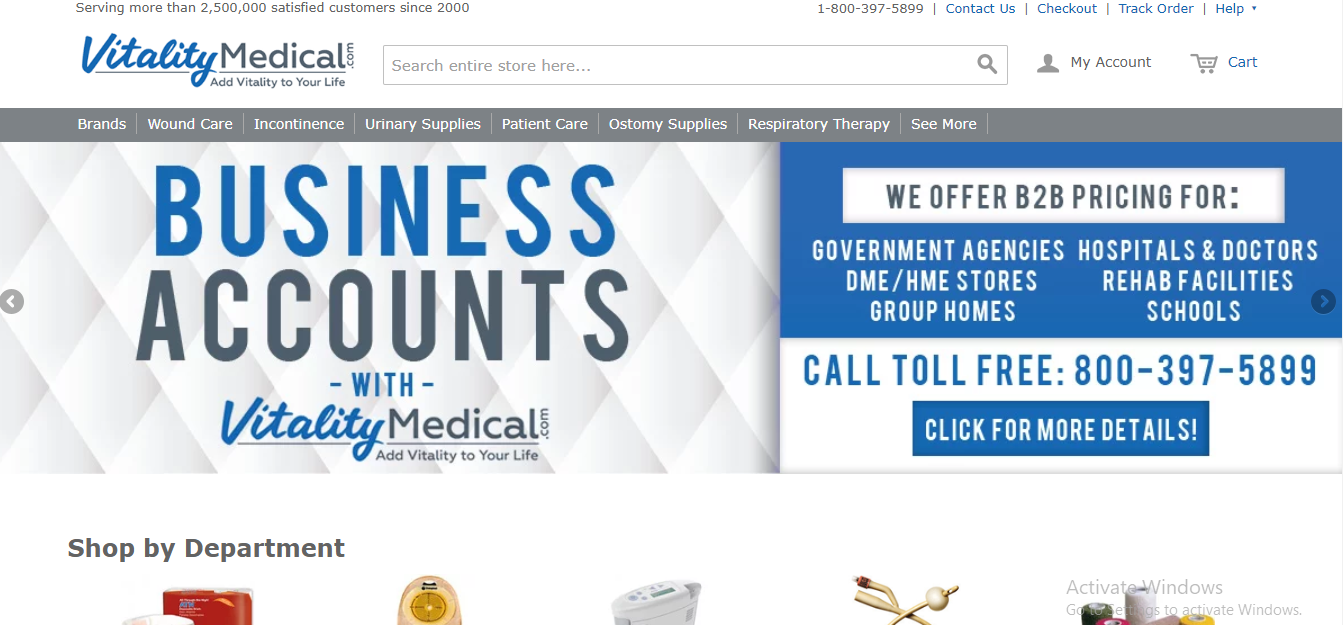
The Future of B2B eCommerce
ECommerce is rapidly evolving and increasingly becoming a vital channel for businesses to replace traditional commerce methods. So, what can you expect from B2B eCommerce 2025?
- A surge in subscription-based models in B2B eCommerce as this business approach gains popularity and efficiency.
- The expansion of mobile commerce will persist. Businesses must ensure their websites are mobile-optimized, prioritizing speed, convenience, and user experience.
- The B2B eCommerce market will further fragment as diverse industries embrace this approach. To thrive, businesses will need to specialize in specific niches.
- While historically dominated by B2C, social media platforms are now being embraced by B2B businesses to effectively engage with their target audience.
- B2B marketplaces are a new revenue stream. iBe forecasts that by 2025, B2B marketplaces will be worth $3.6 trillion and represent 30% of global sales.
These trends reflect the dynamic nature of B2B eCommerce and the need for businesses to adapt and innovate to stay competitive in this evolving landscape.
Final Words
Business to business or B2B eCommerce is a potential and tremendous market for many businesses to participate in. But, it is not easy to be successful if people have a lack of background knowledge about the online B2B platform. Therefore, this article is written with the purpose of helping business doers or anybody who is now paying great attention to the B2B eCommerce marketplace have a deeper understanding of this growing industry.


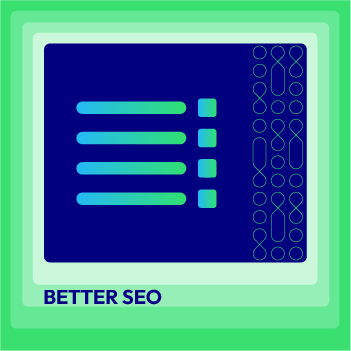
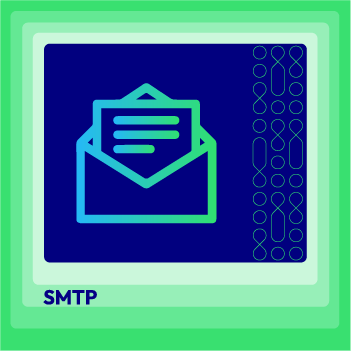
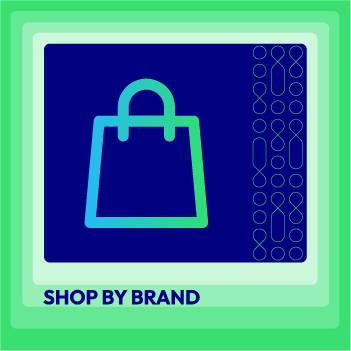



![Top 20+ Must-have Shopify Apps for 2025 [Free & Paid] - Mageplaza](https://cdn2.mageplaza.com/media/blog/must-have-shopify-apps/top-must-have-shopify-apps.png)
![[2025 Updates] Top 10+ Upsell Apps for Shopify - Mageplaza](https://cdn2.mageplaza.com/media/blog/best-upsell-shopify-app/cover.png)